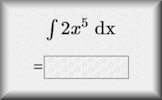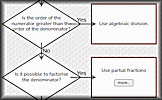Here are some specific activities, investigations or visual aids we have picked out. Click anywhere in the grey area to access the resource.
 Integration Exercises on indefinite and definite integration of basic algebraic and trigonometric functions.
Integration Exercises on indefinite and definite integration of basic algebraic and trigonometric functions. Integration Video You can't possibly learn all about integration from a 28 minute video so all that this resource can do is provide a quick revision to help you do the online exercise.
Integration Video You can't possibly learn all about integration from a 28 minute video so all that this resource can do is provide a quick revision to help you do the online exercise. Partial Fractions Exercises on mastering the art of partial fraction decomposition.
Partial Fractions Exercises on mastering the art of partial fraction decomposition. Integration Flowchart This flowchart will only be of use to those who have already learnt the techniques mentioned in the IB AA Syllabus.
Integration Flowchart This flowchart will only be of use to those who have already learnt the techniques mentioned in the IB AA Syllabus.
Here are some exam-style questions on this statement:
- "Consider the functions \(f(x)=\sin(x) \text{ and } g(x) = \tan(x+\frac{\pi}{2})\) in the region where \(\frac{\pi}{2}\le x \le \pi\)" ... more
- "The curve \( y=\sin(\sqrt{x}) \text{ where } x \ge 0 \) intersects the x axis at the points \(x_0, x_1, x_2, x_3, x_4, ... \) and \(x_0 = 0\)." ... more
- "A function \( f \) is defined by \( f(x) = \arccos\left(\frac{x^2}{1-x^4}\right) \), \( x \in \mathbb{R} \), \( 0.785 \lt |x| \lt 5\)." ... more
Click on a topic below for suggested lesson Starters, resources and activities from Transum.
Furthermore
See the main Partial Fractions section of the syllabus in Number and Algebra.
Here is an example of how to use partial fractions to decompose the rational function \( \dfrac{2x-5}{(x-2)(x+1)^2} \):
$$\begin{aligned} \frac{2x-5}{(x-2)(x+1)^2} &= \frac{A}{x-2} + \frac{B}{x+1} + \frac{C}{(x+1)^2} \\ &= \frac{A(x+1)^2 + B(x-2)(x+1) + C(x-2)}{(x-2)(x+1)^2} \end{aligned} $$Multiplying both sides by the common denominator gives:
$$2x-5 = A(x+1)^2 + B(x-2)(x+1) + C(x-2)$$Substituting \(x = 2\) gives:
$$-1 = 9A$$ $$A = -\dfrac{1}{9}$$Substituting \(x = -1\) gives:
$$-7 = -3C$$ $$C = \dfrac{7}{3}$$Finally, substituting \(x = 0\) gives:
$$-5 = A - 2B -2C$$Substituting A and C gives:
$$-5 = \left(-\frac{1}{9}\right) - 2B + -2\left( \frac{7}{3} \right)$$ $$B = \dfrac{1}{9}$$Therefore, we have:
$$\frac{2x-5}{(x-2)(x+1)^2} = -\frac{1}{9(x-2)} + \frac{1}{9(x+1)} + \frac{7}{3(x+1)^2}$$How do you teach this topic? Do you have any tips or suggestions for other teachers? It is always useful to receive feedback and helps make these free resources even more useful for Maths teachers anywhere in the world. Click here to enter your comments.

